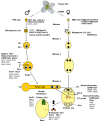Epigenetic Regulation of Plant Gametophyte Development
- PMID: 31234519
- PMCID: PMC6627097
- DOI: 10.3390/ijms20123051
Epigenetic Regulation of Plant Gametophyte Development
Abstract
Unlike in animals, the reproductive lineage cells in plants differentiate from within somatic tissues late in development to produce a specific haploid generation of the life cycle-male and female gametophytes. In flowering plants, the male gametophyte develops within the anthers and the female gametophyte-within the ovule. Both gametophytes consist of only a few cells. There are two major stages of gametophyte development-meiotic and post-meiotic. In the first stage, sporocyte mother cells differentiate within the anther (pollen mother cell) and the ovule (megaspore mother cell). These sporocyte mother cells undergo two meiotic divisions to produce four haploid daughter cells-male spores (microspores) and female spores (megaspores). In the second stage, the haploid spore cells undergo few asymmetric haploid mitotic divisions to produce the 3-cell male or 7-cell female gametophyte. Both stages of gametophyte development involve extensive epigenetic reprogramming, including siRNA dependent changes in DNA methylation and chromatin restructuring. This intricate mosaic of epigenetic changes determines, to a great extent, embryo and endosperm development in the future sporophyte generation.
Keywords: DNA methylation; chromatin; epigenetics; gametophyte; gene expression; plant development; siRNA.
Conflict of interest statement
The authors declare no conflicts of interest.
Figures

Similar articles
-
Maternal regulation of seed growth and patterning in flowering plants.Curr Top Dev Biol. 2020;140:257-282. doi: 10.1016/bs.ctdb.2019.10.008. Epub 2019 Nov 19. Curr Top Dev Biol. 2020. PMID: 32591076
-
Transcriptome analysis of the Arabidopsis megaspore mother cell uncovers the importance of RNA helicases for plant germline development.PLoS Biol. 2011 Sep;9(9):e1001155. doi: 10.1371/journal.pbio.1001155. Epub 2011 Sep 20. PLoS Biol. 2011. PMID: 21949639 Free PMC article.
-
Cross-Talk Between Sporophyte and Gametophyte Generations Is Promoted by CHD3 Chromatin Remodelers in Arabidopsis thaliana.Genetics. 2016 Jun;203(2):817-29. doi: 10.1534/genetics.115.180141. Epub 2016 Apr 13. Genetics. 2016. PMID: 27075727 Free PMC article.
-
The long and winding road: transport pathways for amino acids in Arabidopsis seeds.Plant Reprod. 2018 Sep;31(3):253-261. doi: 10.1007/s00497-018-0334-5. Epub 2018 Mar 16. Plant Reprod. 2018. PMID: 29549431 Review.
-
Plant germline formation: common concepts and developmental flexibility in sexual and asexual reproduction.Development. 2015 Jan 15;142(2):229-41. doi: 10.1242/dev.102103. Development. 2015. PMID: 25564620 Review.
Cited by
-
Hypermethylation of Auxin-Responsive Motifs in the Promoters of the Transcription Factor Genes Accompanies the Somatic Embryogenesis Induction in Arabidopsis.Int J Mol Sci. 2020 Sep 18;21(18):6849. doi: 10.3390/ijms21186849. Int J Mol Sci. 2020. PMID: 32961931 Free PMC article.
-
Epigenetic Regulation of Auxin-Induced Somatic Embryogenesis in Plants.Int J Mol Sci. 2020 Mar 26;21(7):2307. doi: 10.3390/ijms21072307. Int J Mol Sci. 2020. PMID: 32225116 Free PMC article. Review.
-
Genomic methylation patterns in pre-meiotic gynoecia of wild-type and RdDM mutants of Arabidopsis.Front Plant Sci. 2023 Mar 13;14:1123211. doi: 10.3389/fpls.2023.1123211. eCollection 2023. Front Plant Sci. 2023. PMID: 36993852 Free PMC article.
-
Whole Mount Staining and Immunolocalization Procedures for Developing Ovules of Vigna unguiculata.Methods Mol Biol. 2025;2900:293-303. doi: 10.1007/978-1-0716-4398-3_19. Methods Mol Biol. 2025. PMID: 40380069
-
Cytological and transcriptomic analyses provide insights into the pollen fertility of synthetic allodiploid Brassica juncea hybrids.Plant Cell Rep. 2023 Dec 27;43(1):23. doi: 10.1007/s00299-023-03089-4. Plant Cell Rep. 2023. PMID: 38150101
References
-
- Friedman W.E., Madrid E.N., Williams J.H. Origin of the fittest and survival of the fittest: Relating female gametophyte development to endosperm genetics. Int. J. Plant Sci. 2008;169:79–92. doi: 10.1086/523354. - DOI
Publication types
MeSH terms
LinkOut - more resources
Full Text Sources

